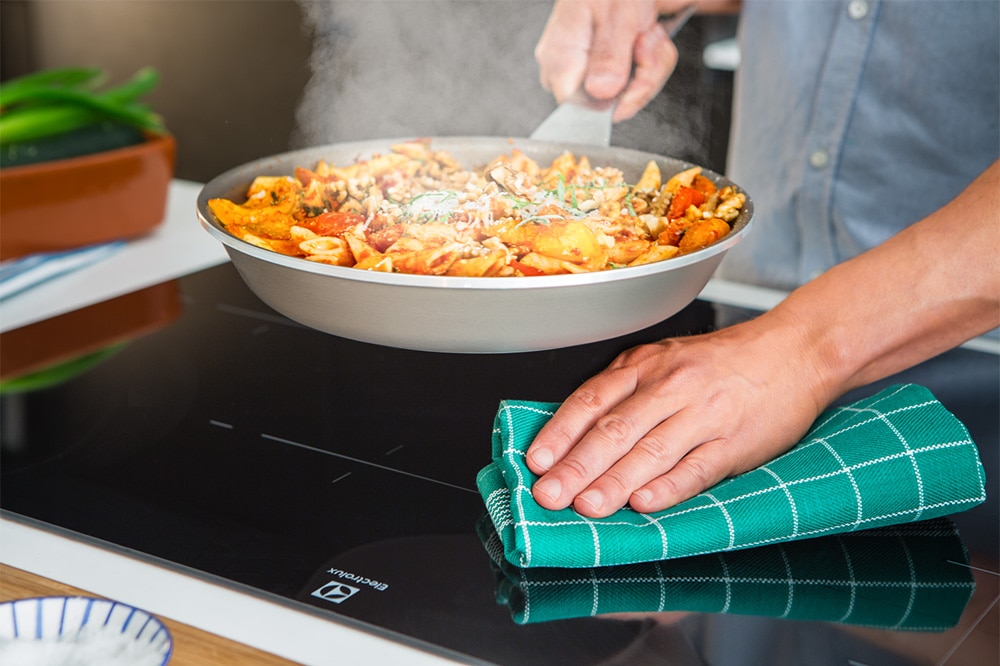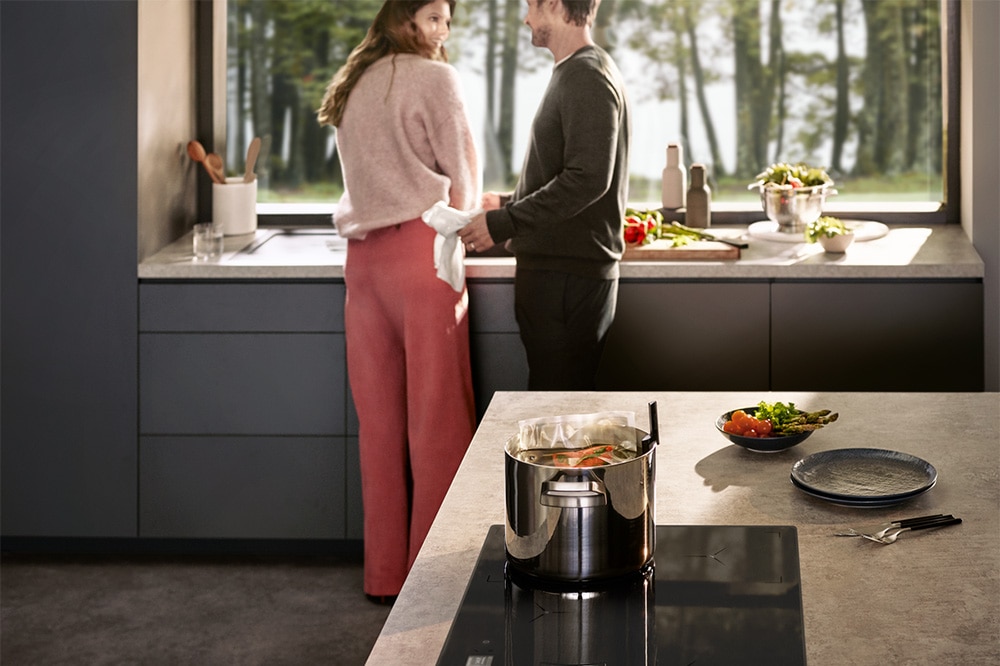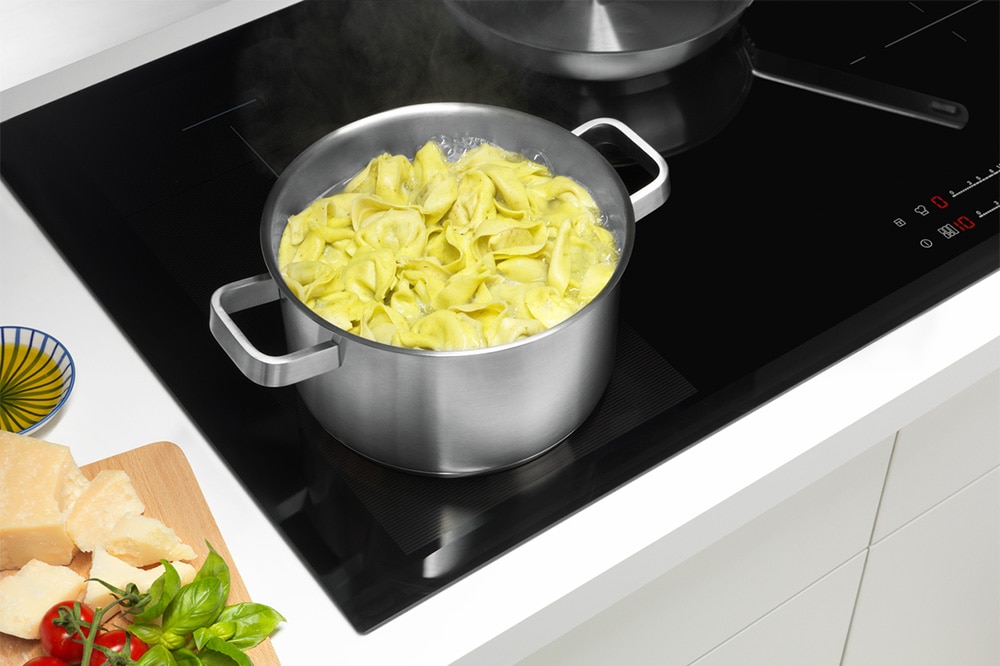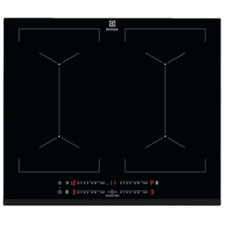In the realm of modern kitchens, choosing the right hob can significantly enhance your cooking experience. Induction hobs and radiant hobs are two popular choices that deserve a close comparison. Both offer efficient cooking solutions, but they operate on different principles.
Let's delve into the key differences, advantages, and considerations to help you make an informed decision between induction and radiant hobs.
How do induction hobs work?
Induction hobs revolutionize cooking by transforming your pots and pans into heat sources themselves. These innovative hobs utilize copper coils to create electromagnetic energy, directly interacting with compatible cookware. This means your cookware heats up rapidly, allowing for faster and precisely controlled cooking without the need for heat to transfer through a cooking surface.
The advantages don't end there. After cooking, the glass top surrounding the cookware remains cool, making cleaning a breeze.
How do radiant hobs work?
Radiant hobs feature a smooth, flat surface with radiant heat elements underneath. Unlike induction hobs, radiant hobs utilize metal coils heated by electricity and are covered by a ceramic glass sheet. This glass insulates the coil and facilitates rapid heating. The heat is then transferred to the cooking vessel, which further heats the food.
Some variants use gas flames under the ceramic surface, offering flexibility in cooking methods. While no special cookware is required, flat-bottomed pots and pans aid in even heat distribution.
4 differences between induction hob and radiant hob
When considering the choice between induction and radiant hobs, it's essential to understand the key differences in their operation and benefits. Let's explore the nuances of both hob types, ensuring you can make an informed decision for your kitchen.
1. Cookware compatibility
Induction hobs operate on the principle of magnetism. If a magnet adheres to your cookware, it's induction-ready and will work efficiently on an induction hob. However, not all cookware is compatible. Materials like cast iron, certain types of steel, and even some non-stick pans inherently work well on induction hobs.
On the other hand, radiant hobs are more versatile when it comes to cookware. They don't rely on magnetic properties, allowing a broader range of pots and pans to be used without compatibility concerns.
You can find more helpful guidance from our Induction hob FAQs.
2. Cooking speed and techniques
Induction cooking boasts a notable advantage in speed over traditional electric cooking. The hob's immediate response to temperature adjustments ensures faster cooking, providing a convenient and efficient experience in the kitchen. However, it may require a slight adjustment in your cooking technique due to its requirement of direct contact with the pan. Stirring and flipping while keeping the pan on the hob ensures optimal results.
Radiant hobs offer effective cooking but might have a slightly slower response to temperature adjustments compared to induction. However, they allow more flexibility in cooking techniques, enabling you to lift the pan for tossing or stirring without triggering an error code.
3. Appearance and controls
Induction hobs typically resemble flat-top electric hobs, featuring a smooth ceramic-glass top that hides the heating elements. The design is sleek and modern, integrating well with contemporary kitchen aesthetics. Many induction hobs come with buttons and screens for precise temperature adjustments, and some offer traditional knobs for those who prefer a classic look.
Also, radiant hobs have a smooth ceramic-glass surface but may have visible coil elements. They are available with both buttons and knobs for controls, catering to varying design preferences.
4. Maintenance and care
Maintaining an induction hob is relatively easy. As the heat comes directly from the cookware, spills or food residue on the surface are less likely to burn and harden. Cleaning is straightforward, and the hob cools down faster after cooking, making it easier to maintain.
Radiant hobs require similar care but might need a bit more attention to prevent burned-on food. Caution is necessary to avoid scratching the surface while moving heavy pots and pans.
Induction hob vs Radiant hob: Advantages and disadvantages

The pros of induction hobs
- Safety first: Induction hobs are inherently safer as they only generate heat when compatible cookware is placed on them, preventing accidental burns.
- Rapid response: Induction hobs swiftly heat cookware upon contact, offering faster cooking compared to traditional electric hobs.
- Easy cleaning: The flat, glass surface of induction hobs is effortless to clean with a microfiber cloth, ensuring a neat kitchen.
- Energy efficiency: With direct heating of the cookware, induction hobs are more energy-efficient compared to conventional electric hobs.
- Precise control: Induction technology provides precise temperature control, responding instantly to adjustments, granting the user superior control over cooking.
For further information please refer to these tutorial videos for Induction hobs from Electrolux.
Here are more kitchen tips
The cons of induction hobs
- Higher initial cost: Induction hobs come at a higher price point and may require investment in compatible cookware.
- Specific cookware needed: Induction hobs demand magnetic-based cookware, excluding aluminium, copper, and non-magnetic stainless-steel pans.
- Surface vulnerability: The glass surface of induction hobs is prone to scratching, necessitating careful usage and maintenance.
The pros of radiant hobs
- Cost-effective choice: Standard radiant hobs are more affordable, making them a budget-friendly option for many.
- Cookware versatility: Radiant hobs allow the use of a wide range of cookware materials, unlike induction hobs that require magnetic-compatible pots and pans.
- Ease of cleaning: Similar to induction, radiant hobs boast a smooth, glass surface, making them easy to clean and maintain.
The cons of radiant hobs
- Delayed heating: Radiant hobs take longer to heat up, both the burner and the pan, leading to delayed cooking.
- Energy inefficiency: They are less energy-efficient compared to induction hobs due to heat loss during transfer from the burner to the pan.
- Uneven heating: Radiant hobs may have uneven heat distribution, impacting cooking results in various areas of the hob.
- Surface fragility: Being made of glass, the surface of radiant hobs is susceptible to scratching, requiring caution during use.
Induction hob vs Radiant hob: Choosing the right one
When choosing between an induction hob and a radiant hob, the choice is very personal and depends on your preferences and priorities. If you prioritize energy efficiency, precise control, and a modern look, an induction hob might be the ideal choice.
However, if you prefer a more affordable option with familiar cooking techniques, a radiant hob might suit you better. Consider your cooking style, kitchen needs, and budget before making the final decision.
Cook safely and efficiently with Electrolux stoves & hobs
When it comes to cooking, safety and efficiency are paramount. Electrolux induction hobs offer a range of advantages that make them the ideal choice for your kitchen.
One of the standout features of Electrolux hobs is their high-quality glass cooking surfaces. These surfaces are not only easy to clean but also highly resistant to scratches, ensuring that your kitchen maintains its pristine appearance over time.
Plus, Electrolux induction hobs are known for their speed and energy efficiency. Cooking with induction means you can create delicious dishes in less time while using less energy. This not only saves you time but also contributes to a greener, more sustainable kitchen.
-
- Simply beautiful - on and off
- FlexiBridge® adapts to different sized dishes
- Hood automatically responds to the hob
-
- PowerBoost provides quick, intense heat.
- Pre-set programs help you deliver great results.
- Induction is safe, fast, and energy efficient.
-
- Induction technology, the fastest way to taste
- Induction: easy, fast and safe
- Hood automatically responds to the hob
-
- Connect zones to increase cooking space
- Large cooking zones on both sides
- Infinite heating zones
FAQs about Induction hob vs Radiant hob
-
1. What cookware should I use with my induction hob?
To optimize your induction hob, choose cookware compatible with induction technology. Induction-ready pots and pans are those that a magnet adheres to, ensuring effective heat transfer. Options like cast iron and specific stainless steel cookware work excellently.
-
2. How do I clean an induction or radiant hob?
Maintaining your hob is a breeze. Use a soft cloth and a gentle cleaner suitable for the glass surface. For induction, the advantage is the cool surface, allowing spills to be wiped easily without sticking.
-
3. Is induction cooking healthy?
Absolutely, induction cooking is a healthy choice. It excels in efficiency and precision, ensuring your food is cooked thoroughly while retaining essential nutrients, thanks to its precise temperature control.
-
4. Is there any difference in the durability of the glass-ceramic surfaces on electric and induction hobs?
Both electric and induction hobs offer robust glass-ceramic surfaces. However, induction hobs tend to have an added durability advantage due to their surface remaining cooler during cooking.
If your Electrolux induction hob has any issue, you can contact the Induction hob repair service here for inspection. -
5. Can I slow cook on my induction hob?
Yes, you can indeed indulge in slow cooking on your induction hob. Opt for appropriate cookware and set your induction hob to a low, consistent temperature for simmering and slow cooking your favourite dishes with ease.




